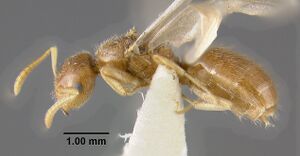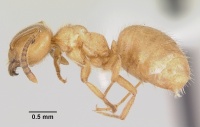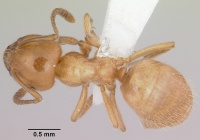Lasius creightoni
| Lasius creightoni | |
|---|---|

| |
| Scientific classification | |
| Kingdom: | Animalia |
| Phylum: | Arthropoda |
| Class: | Insecta |
| Order: | Hymenoptera |
| Family: | Formicidae |
| Subfamily: | Formicinae |
| Tribe: | Lasiini |
| Genus: | Lasius |
| Section: | flavus clade |
| Species group: | claviger |
| Species: | L. creightoni |
| Binomial name | |
| Lasius creightoni (Wing, 1968) | |
Known only from the type collection made in the La Sal mountains in Utah.
Identification
Keys including this Species
- Key to Lasius-Nearctic Acanthomyops males
- Key to Lasius-Nearctic Acanthomyops queens
- Key to Lasius-Nearctic Acanthomyops workers
- Key to North American Lasius Species
Distribution
Only known from the La Sal Mountains, Utah.
Latitudinal Distribution Pattern
Latitudinal Range: 39.76943° to 37.828569°.
| North Temperate |
North Subtropical |
Tropical | South Subtropical |
South Temperate |
- Source: AntMaps
Distribution based on Regional Taxon Lists
Nearctic Region: United States (type locality).
Distribution based on AntMaps
Distribution based on AntWeb specimens
Check data from AntWeb
Countries Occupied
| Number of countries occupied by this species based on AntWiki Regional Taxon Lists. In general, fewer countries occupied indicates a narrower range, while more countries indicates a more widespread species. |

|
Estimated Abundance
| Relative abundance based on number of AntMaps records per species (this species within the purple bar). Fewer records (to the left) indicates a less abundant/encountered species while more records (to the right) indicates more abundant/encountered species. |

|
Biology
Wing (1968) - Professor Creighton's collection located in the MCZ consisted of 3 specimens of each caste. The date on the specimens was July 1933. Wilson (1955) cites a collection of Lasius fallax made by Creighton at the Warner Ranger Station, Moab, Utah, on July 19, 1933. Because he collected over a wide area during the summer of 1933, it is likely that A. creightoni was taken on or near July 19. Little variation is evident in either metric or conventional characters. The only ecological data is that the Warner Ranger Station is at an altitude of about 4000 feet. Nuptial flights may not have started at the time of collection, since all 3 castes were in the nest; flights may occur sometime in late July or early August.
Castes
   
| |
| . | Owned by Museum of Comparative Zoology. |
Nomenclature
The following information is derived from Barry Bolton's Online Catalogue of the Ants of the World.
- creightoni. Acanthomyops creightoni Wing, 1968: 141, figs. 177-185 (w.q.m.) U.S.A. Combination in Lasius: Ward, 2005: 13.
Unless otherwise noted the text for the remainder of this section is reported from the publication that includes the original description.
Description
Worker
Pilosity and pubescence similar to that of queen, but somewhat less dense. Antennae slender. Crest of petiolar scale broadly and shallowly emarginate, sides more or less straight. Color pale yellow, body shining.
Queen
Distinct from all other known species of Acanthomyops. Body pilosity fairly dense, simple to finely barbulate, delicate, whitish to silvery in appearance. Pubescence dilute to moderately dense, also whitish to silvery, much of it unusually long, loosely appressed to suberect, conspicuous on antennal scapes, gula, and gaster. Antennae slender. Crest of petiolar scale moderately sharp, shallowly emarginate; sides straight, converging slightly dorsally. Color light brownish yellow, appendages lighter, body shining.
Male
Pilosity and pubescence as in queen, but considerably less dense. Longer hairs at posterior tip of gaster 0.20 mm or more. Crest of petiolar scale moderately sharp to sharp, feebly and broadly emarginate. Antennae slender, SI 70 or greater. HW 0.85 mm or less, CI less than 105. Scutum and scutellum finely sculptured, largely free of pubescence. Color light brown, head darker, appendages lighter, body somewhat shining.
Type Material
Type locality: Warner Ranger Station, La Sal Mts., Moab, Grand Co., Utah. Location of types: Holotype female, 2 paratype females, 3 paratype males, and 3 paratype workers in the Museum of Comparative Zoology.
Etymology
This species is named for the collector, Dr. W. S. Creighton, Emeritus Professor of Biology, City College of New York.
References
- Bolton, B. 1995b. A new general catalogue of the ants of the world. Cambridge, Mass.: Harvard University Press, 504 pp. (page 53, catalogue)
- Ward, P.S. 2005. A synoptic review of the ants of California (Hymenoptera: Formicidae). Zootaxa 936: 1-68 (page 13, new combination in Lasius (Acanthomyops))
- Wing, M. W. 1968a. Taxonomic revision of the Nearctic genus Acanthomyops (Hymenoptera: Formicidae). Mem. Cornell Univ. Agric. Exp. Stn. 405: 1-173 (page 141, figs. 177-185 worker, queen, male described)
References based on Global Ant Biodiversity Informatics
- Allred D. M. 1982. Ants of Utah. The Great Basin Naturalist 42: 415-511.
- Allred, D.M. 1982. The ants of Utah. Great Basin Naturalist 42:415-511.
- Wing M. W. 1968. Taxonomic revision of the Nearctic genus Acanthomyops (Hymenoptera: Formicidae). Memoirs of the Cornell University Agricultural Experiment Station 405: 1-173.


